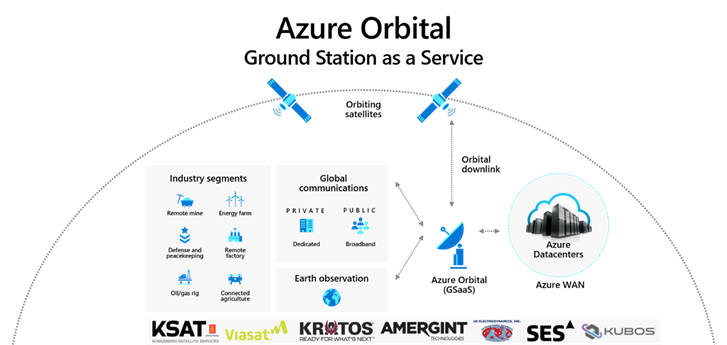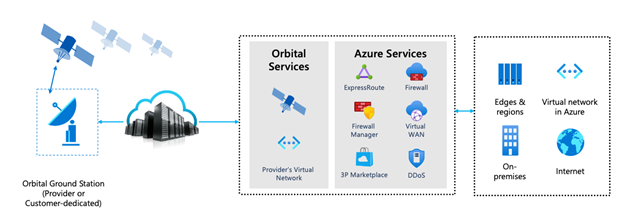Data collected from space to observe Earth is instrumental in helping address global challenges such as climate change and furthering of scientific discovery and innovation. The cloud is central to both modern communications scenarios for remote operations and the gathering, processing, and distributing the tremendous amounts of data from space.
Today we’re announcing the preview of Azure Orbital. The new ground station service enables satellite operators to communicate to and control their satellites, process data, and scale operations directly with Microsoft Azure. With Azure Orbital, the ground segment, including the ground stations, network, and procedures, becomes a digital platform now integrated into Azure and complemented by many partners.
Amergint, Kratos, KSAT, Kubos, Viasat, and US Electrodynamics INC. and have joined the ecosystem of Azure Orbital partners, each of them bringing their unique value and expertise for the benefits of our customers.
Microsoft is well-positioned to support customer needs in gathering, transporting, and processing of geospatial data. With our intelligent cloud and edge strategy currently extending over 60 announced cloud regions, advanced analytics, and AI capabilities coupled with one of the fastest and most resilient networks in the world—security and innovation are at the core of everything we do.

Azure Orbital scenarios
Earth observation and IoT
Satellite images are used in many industries. Areas such as meteorology, oceanography, agriculture, geology, and defense and intelligence most often use satellites that are in a non-geostationary orbit (NGSO), including low-earth orbit (LEO) or medium-earth orbit (MEO). As the satellites are orbiting, a substantial amount of ground stations are required to establish contact within a specific time window to downlink the data to Earth.
Azure Orbital enables satellite operators to schedule contacts with their spacecrafts and directly downlink data into their virtual network (VNet) in Azure. Azure Virtual Networks are isolated, highly secure, and governed by Microsoft’s more than 90 compliance certifications covering applications and datasets.
Azure Orbital on-ramps your data directly into Azure, where it can immediately get processed with market-leading data analytics, geospatial tools, machine learning, and Azure AI services.
Contact scheduling will be available for Microsoft owned and operated ground stations in X, S, and UHF band frequencies via shared high gain antennas. We are also directly interconnecting our global network with our partner’s ground station networks for easy scheduling with your preferred Teleport operators while maintaining the benefits of direct integration with Azure.
Whether you choose to use Microsoft or partner ground stations, the digitized Radio Frequency (RF) signal from the antenna to the cloud can be transmitted using the VITA Radio Transport (VRT) format (VITA-49) and then subsequently be demodulated using custom modems or cloud modems offered by the platform.

Global communications
In-flight connectivity (IFC), maritime, connected cruise, mobility, and video broadcasting are examples of communication scenarios addressed by the space industry. Leveraging Azure Orbital, satellite operators can go beyond selling network capacity with the accelerated building of managed services. Azure Orbital offers interconnection of your existing ground stations and colocation of dedicated antennas close to our network PoPs or Datacenters. Orbital enables you to take full advantage of our global network and services infrastructure to build new product offerings and service chains with the edge, 5G, SD-WAN, and AI while continuously optimizing your operations and footprint.

SES has selected Microsoft Azure to collocate the ground stations (including Telemetry, Tracking, and Command Systems) of their next-generation SES O3b mPOWER communication system. SES has designed a cloud-scale operational environment and will leverage Azure Orbital as a core platform to scale and build managed services and streamline order and service delivery management processes.
“In the last 12 to 18 months, our focus has been to accelerate our customers’ cloud adoption plans. We are pleased to have found an ideal partner in Microsoft with its new Azure Orbital system. This partnership leverages both companies’ know-how—SES’s experience in satellite infrastructure and Microsoft’s cloud expertise—and is building blocks in developing new and innovative solutions for the future,” said JP Hemingway, CEO of SES Networks.“we are thrilled that we will be co-locating, deploying and operating our next-generation O3b mPOWER gateways alongside Microsoft’s data centers. This one-hop connectivity to the cloud from remote sites will enable our MEO customers to enhance their cloud application performance, optimize business operations with much flexibility and agility needed to expand new markets.”
The ground segment is a significant part of any satellite operator’s investments. An ecosystem of partners has joined our Managed Service Providers (MSP) program to enrich the platform by selecting services and technology integrations. Cloud modems optimized for Azure, Mission Control Operations are examples of third-party cloud-native services provisioned on-demand when your business needs it.
Azure Orbital is now in preview. For questions, feedback, and interest to participate in the preview, please contact [email protected]. Please visit our product documentation to learn more, share feedback, or express interest in participating in the preview.
Learn more about Azure Orbital
Azure. Invent with purpose.
